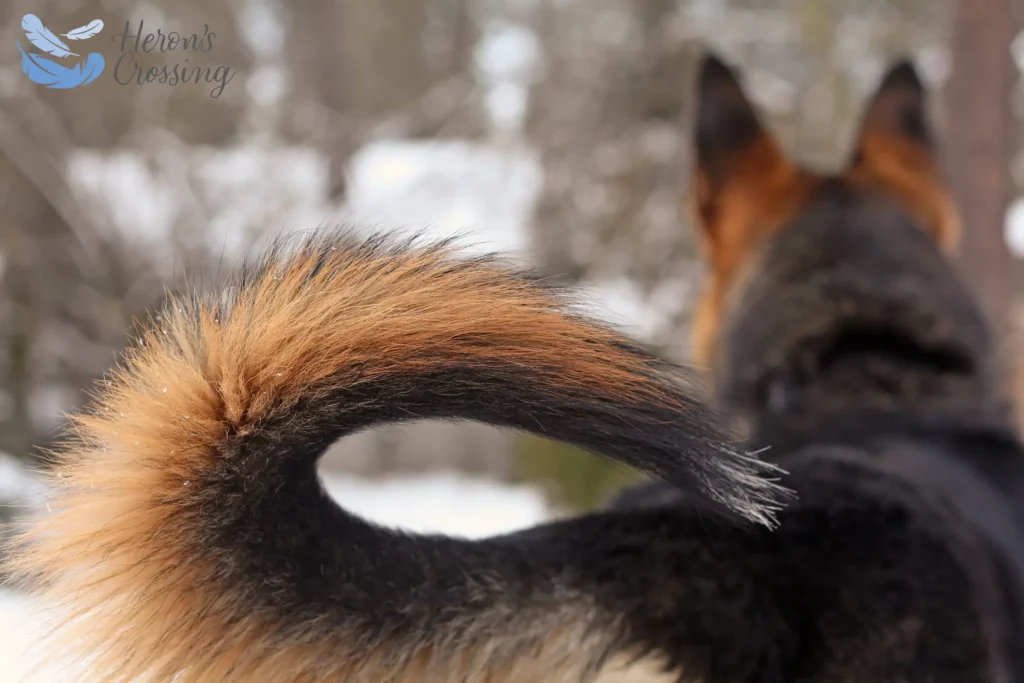Puppies learn ‘bark’ language from adult dogs, and how to use their tails for communicating long distance as well as face to face. Scientists have studied these movements. Although their studies tend to correlate, there are always exceptions.
The tail is an extension of the spine. Pulling or injuring the tail can cause a lot of pain and injury all the way up the spine and thus affect every part of the body. Motion is activated from the top of the rump on the back, not farther down, as most people might think.
Different breeds have special tail features. This may give you a clue to your dog’s breed.
Tiny Tails include bobtails, corkscrew tails and stubby ‘carrot’ tails. You’ll see these on Corgis, Terriers, Pugs and Bulldogs. All their tails can do is shake with excitement. These are usually ‘digger’ dogs who enjoy going after underground animals.
Cold Weather Breeds like the Siberian Husky and Alaskan Malamute have big, sweeping, C-shaped brushy tails, or more tightly curled brushy tails that come up over the back to help them hold in body heat. This helps especially to protect them from the cold as they sleep. Pomeranians, too! Their ancestors were sled dogs.
Sporting Types have ‘working’ tails that help them in their activities. A high-set tail that rises upward on the dog’s rump is common to hunting dogs like Beagles, English Setters, Airedales and Dalmations. It helps to signal the pack or their human hunting partners.
Poodles are also ‘tufted’ high tailed dogs. They were originally bred to hunt fowl. Dachshunds are also part of this group. They used to dig after badgers and hunt wild boar.
Pointers have a long, pointed ‘sword tail’ that they extend horizontally on full alert when they have spotted their target. Water dogs such as Retrievers have thick, furry, sturdy ‘otter’ tails that act like a rudder when they are swimming.
Long Tailed dogs have such long tails that they normally droop. German Shepherds, Afghan Hounds, Whippets and Greyhounds have long, low-set ‘saber’ tails that hang down, often with a curl at the end. An elegant expression of the long tail is the wispy fan tail of the ‘plumed’ Borzoi and Saluki.
When it comes to dog-speak, dogs basically use Up, Middle, Down and Side movements, emphasized by the intensity of the positioning or wag.
High Position- projects power or a willingness to stand their ground. If there is no wagging, they just want to be left alone. “Stop!” But a very high tail with shaking or wagging is warning that the dog will attack. People may easily misinterpret this wagging as a friendly gesture. Stay away.
Middle Position – at body level means the dog is relaxed and happy if the tail is relaxed in a sort of U shape. If the tail is pointed straight out, there is curiosity. If slightly curled at the tip, it’s a question mark. Now look at the nuances:
- Little wags – friendly.
- Slow wags – unsure of the situation.
- Tip wag only – unsure of the situation as he sees you coming toward him. He’s signaling that he means no harm, do you?
- Hip wiggle – very happy.
- Circular wag – extremely happy.
The direction of the tail says a lot, too. For high tailed and cold weather breeds whose natural high tail may be confusing, watch the side to side motion for clues. The dog moves his tail to the opposite side of the brain where the thoughts and emotions are coming from.
- Wags to dog’s Right – Good feelings. He’s happy. Just think, “Right means alright.”
- Wags to dog’s Left – unhappy, unsure or insecure. Just remember, “Left means look out.”
Low Position – A lowered tail, curling the tail under the body or even hunching down to look smaller means the dog is fearful or submissive. The tip of the tail may wiggle as if to say, “Please don’t hurt me. I’m nice.”
What do dog tails tell you? Knowing this information can be especially useful when you and your pet are around strange dogs at the park. If you are introduced to a dog with a high, wagging, shaking tail, or if it is positioned to his left side, keep your distance and wait for the large posturing to subside.
Heron’s Crossing provides end-of-life care for pets in the Metro Atlanta area. In-home appointments with compassionate vets are available. If you’d prefer a home-like setting away from your home, our Decatur office is also available by appointment.

